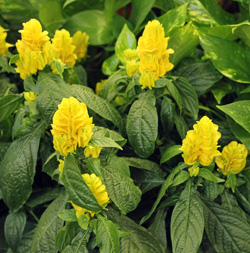
Golden shrimp plant is an evergreen shrub popular as a landscape plant in tropical and subtropical areas. In the Midwest it is easily grown as an interesting flowering houseplant or seasonal annual during the summer months. Also called golden candle or lollypop plant, Pachystachys lutea is a soft-stemmed, broadleaved plant in the acanthus family (Acanthaceae). It is native to lowland areas of Central and South America from El Salvador to Peru.
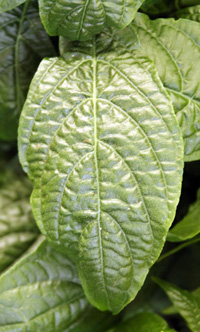
In warm climates golden shrimp plant can grow 3-6 feet tall but in container culture it can be kept much shorter. The opposite, lance-shaped leaves that grow 2-6 long are heavily veined, giving a corrugated appearance. The branching, woody stems are covered with simple, dark green leaves that create a stunning contrast with the bright flower spikes.
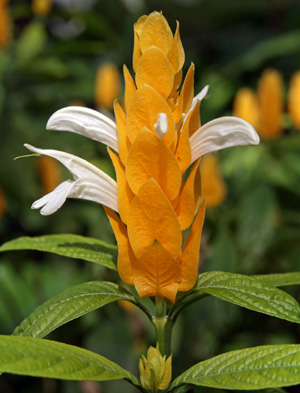
The overlapping, bright yellow bracts of the 4-sided, 3-5″ long conical inflorescences give this plant its common name, as they vaguely resemble the crustacean we eat. The flower spikes are held upright, above the dark foliage. The individual flowers are narrow, white, two-lipped tubes that partially protrude from the showy bracts. Each raceme has numerous flowers that open sequentially up the spike.
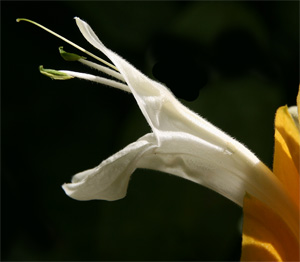
In the tropics, this plant will bloom throughout the year; in temperate areas, it is more seasonal, blooming primarily in summer unless kept in very high light conditions. In the tropics small capsules containing numerous seeds follow the flowers.
Golden shrimp plant is an exotic addition to the Midwestern garden. Use it as an accent plant on the patio in a mixed container or as an individual potted plant arranged with other containers.

In tropical and subtropical areas it is used as a hedge, for a foundation planting, added to borders and used in mass plantings. Some of these effects could also be achieved in temperate areas on a temporary basis if planted in the ground. Since they have a tendency to get leggy, underplant with complementary annuals or other plants to hide the sparsely-leaved lower part of the plant. Or just grow this attractive plant as a houseplant year-round!
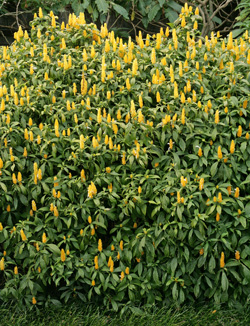
Golden shrimp plant is easily grown in the ground as a summer annual in rich, moist soil in full sun (light shade in southern states) or as a houseplant. Plants in containers can be moved outside during the warm months and returned indoors to overwinter in a greenhouse or bright window. Being a tropical plant it cannot tolerate cold temperatures and may drop leaves if air temperatures go below 60ºF. Any plants that are to be overwintered need to be moved indoors in late summer or early fall before nighttime temperatures get into the low 40ºFs. In-ground plants may survive a light frost, but will be leafless and take a long time to recover.
Indoors water sparingly in the winter and increase watering as the plant begins to resume growth in the spring. Keep plants evenly moist when in bloom. Plants can be heavily pruned to maintain a reasonable size and to shape the plant. If left unpruned, the plants will get leggy and top heavy. Deadheading will encourage bushiness and additional blooms. Pinching the growing tips will encourage branching for a fuller plant. They should also be fertilized regularly to maintain good blooming; blossom booster fertilizers are recommended.
This plant has few pests, but is susceptible to the common insects that often infest houseplants, including aphids, mealybugs, scales, spider mites and whiteflies. It is easily propagated from softwood and semi-ripened stem cuttings taken in early summer. Use 4″ long stem tips and use rooting hormone to increase the success rate.
– Susan Mahr, University of Wisconsin – Madison
Latest from Wisconsin Yard & Garden
Ask Your Gardening Question
If you’re unable to find the information you need, please submit your gardening question here:





 Marigolds
Marigolds Create a Butterfly Garden
Create a Butterfly Garden Plant Flowers to Encourage Beneficial Insects
Plant Flowers to Encourage Beneficial Insects Forcing Bulbs
Forcing Bulbs


